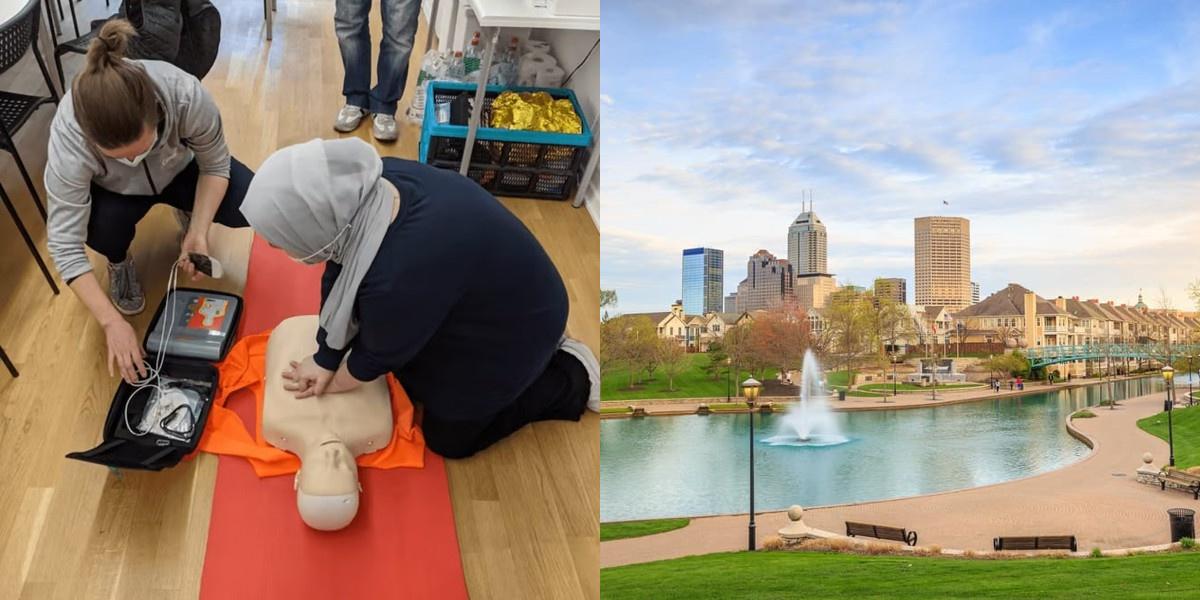What is a Paramedic?
A paramedic is a healthcare professional who provides emergency medical services to individuals in need. They are highly trained and skilled in delivering medical care in critical situations. Paramedics are responsible for assessing patients, administering necessary medical treatments, and transporting them to medical facilities for further care.
Where does a Paramedic work?
Paramedics can work in a variety of settings, including:
- Ambulance Services
- Hospitals
- Fire Departments
- Rescue Squads
- Emergency Medical Services (EMS)
- Air Medical Services
How to Become a Paramedic in Indiana?
To become a Paramedic in Indiana, one must first complete an accredited Paramedic education program, which provides the necessary knowledge and skills. Next, individuals must obtain Paramedic certification by passing the National Registry of Emergency Medical Technicians (NREMT) exam. Once certified, they can then search for and secure Paramedic positions to start earning a competitive salary.
What are the requirements to become a Paramedic in Indiana?
To become a paramedic in Indiana, aspiring individuals must fulfill certain education and legal requirements. These include:
- High school diploma or GED equivalent
- Completion of an accredited paramedic training program
- Obtaining a paramedic license from the Indiana Department of Homeland Security, EMS Commission
Additionally, paramedics must meet certain physical fitness requirements and possess strong problem-solving and communication skills.
Exploring a Career in Paramedic Outside Indiana
If you've been reading this article and long to become a Paramedic, but you live in a different state, don't lose hope – achieving your goal is still within reach. You might consider exploring opportunities to become a Paramedic in Georgia, Kentucky, Mississippi, Utah, or Wyoming. If none of these locations work for you, Dreambound makes it easier than ever to pursue your dreams regardless of your location by simplifying the process of finding and comparing CPR-BLS classes through a convenient search by zip code. With determination and access to the right resources, you can confidently pursue a successful career in healthcare, no matter where you live.
How do I get my Paramedic certification?
Becoming a paramedic is a rewarding and challenging career choice that requires a high level of knowledge, skill, and dedication. Paramedics are healthcare professionals who provide emergency medical care to patients in critical situations. They are often the first responders in emergency situations and play a crucial role in saving lives.
If you are interested in pursuing a career as a paramedic, here are the steps you need to take to get your paramedic certification.
1. Meet the requirements: Before starting your journey as a paramedic, you need to meet certain prerequisites. This includes having a high school diploma or equivalent, being at least 18 years old, possessing a valid driver's license, and having CPR certification. Some paramedic programs may also require you to hold EMT-Basic certification.
2. Complete a paramedic training program: Once you meet the initial requirements, enroll in an accredited paramedic training program. These programs, offered by community colleges, technical schools, and universities, typically last 1 to 2 years. During this time, you will undergo rigorous training that includes classroom lectures, hands-on laboratory sessions, and clinical rotations in healthcare settings. You'll learn advanced medical skills such as trauma management, pharmacology, and advanced life support techniques.
3. Gain clinical experience: Clinical experience is a crucial part of your paramedic training. It provides you with real-world exposure under the supervision of experienced paramedics. During clinical rotations, you'll work in emergency departments, ambulances, and hospitals, applying your knowledge to patient care scenarios. This hands-on experience helps develop your assessment skills, treatment abilities, and critical decision-making capabilities.
4. Pass the NREMT exam: After completing your paramedic training program, you'll need to pass the National Registry of Emergency Medical Technicians (NREMT) exam. This certification exam consists of both written and practical components. The written portion tests your understanding of paramedic concepts, while the practical component evaluates your ability to perform essential skills and procedures effectively.
5. Obtain state certification: Once you've successfully passed the NREMT exam, you must obtain state certification to practice as a paramedic. Each state has its own requirements, so it's essential to research and fulfill specific state certification criteria. In some states, NREMT certification alone may suffice, while others may require additional state-specific exams or training.
How do I get a job as a Paramedic?
After obtaining your paramedic certification, the next step is to find a job as a paramedic. Here are some steps you can take to increase your chances of getting hired as a paramedic:
1. Research job opportunities: Start by researching the job market for paramedics in your area. Look for job openings in hospitals, ambulance services, fire departments, and other healthcare facilities. Check job boards, healthcare websites, and local news sources for job postings.
2. Network: Networking is an important part of any job search. Reach out to paramedics and other healthcare professionals in your area and let them know you are looking for a job. Attend conferences, workshops, and other professional events to meet people in the field. Networking can often lead to job opportunities that may not be advertised.
3. Prepare your resume: Create a professional resume that highlights your education, training, and relevant experience. Include any certifications, clinical rotations, or volunteer work you have completed. Tailor your resume to each job application by emphasizing the skills and experiences that are most relevant to the position.
4. Prepare for interviews: Once you start applying for jobs, be prepared for interviews. Research common interview questions for paramedic positions and practice your responses. Be ready to discuss your clinical experience, problem-solving skills, and ability to work under pressure. Dress professionally and bring any required documents or certifications to the interview.
5. Consider volunteer or part-time positions: If you are having difficulty finding a full-time paramedic job, consider volunteering or working part-time to gain experience and make connections in the field. Many ambulance services and healthcare facilities offer volunteer opportunities or part-time positions that can lead to full-time employment.
6. Continuing education and professional development: Stay up-to-date with the latest advancements in the field of emergency medical services by participating in continuing education courses and professional development opportunities. This will not only enhance your knowledge and skills but also make you a more competitive candidate for future job openings.
Career Paths and Opportunities after Becoming a Paramedic
Becoming a paramedic opens up a wide range of career paths and opportunities. Here are some possible career options for paramedics:
-
Emergency Medical Services (EMS): Many paramedics work in the EMS field, providing emergency medical care in ambulances, fire departments, and other emergency response settings. Paramedics may work in both urban and rural areas, responding to a variety of medical emergencies.
-
Hospital Emergency Departments: Some paramedics choose to work in hospital emergency departments, where they provide immediate care to patients in critical condition. They may assist with resuscitation efforts, administer medications, and assist in the stabilization and transfer of patients.
-
Flight Paramedics: Flight paramedics work on medical helicopters or fixed-wing aircraft, providing critical care to patients who require rapid transport to specialized medical facilities. This role often requires additional training and certification.
-
Event Medical Services: Paramedics may work in event medical services, providing medical coverage at concerts, sporting events, festivals, and other large gatherings. They are responsible for assessing and treating injuries and illnesses that occur during these events.
-
Dispatch and Communication Centers: Some paramedics work in dispatch and communication centers, where they coordinate emergency responses and provide medical advice over the phone. They play a crucial role in ensuring that the appropriate resources are dispatched to the scene of an emergency.
-
Education and Training: Experienced paramedics may choose to become educators and trainers in paramedic training programs or EMS organizations. They teach future paramedics and provide continuing education to current paramedics.
-
Management and Administration: Paramedics with strong leadership and organizational skills may pursue careers in management and administration. They may work as EMS supervisors, operations managers, or in other administrative roles within EMS organizations.
Frequently Asked Questions





